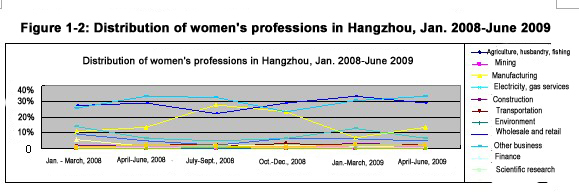Financial crisis hitting women workers harder
The global financial crisis had a profound effect on China's economic and social structure. The country's economic growth slowed and its economic structure underwent various adjustments. After devastating the financial sector, the crisis had a major impact on the real economy. For Chinese women, the job market underwent various changes in terms of employment opportunities and categories of employment. These changes affected women's employment rights and job security.
If we take the Hangzhou economy in 2008 as an example, the financial crisis had two major impacts. First, the number of newly-employed people declined with occupational vacancies dropping; second, many people lost their jobs as companies cut jobs.
I. The structure of women's employment changed as the financial crisis hit the real economy.
At the start of the financial crisis, 75 percent of women workers were employed by limited liability companies, private companies and foreign firms. By the latter stages of the crisis the number of women employed in these sectors fell. We can see the tendency in the following chart of women's employers:

II. The government's policies affect women's occupational choices.
The Chinese government delivered a 4,000 billion yuan (about US$586 billion) economic stimulus package to boost domestic demand. To that end, the government adopted preferential tax policies to stabilize the general job market and to assist disadvantaged women in finding jobs. It also improved small loan programs and encouraged women to improve their working skills. As a result, these government behaviors changed women's occupational pattern.
In the early period of financial crisis, women were mostly hired in manufacturing, wholesale and retail business, community services and other businesses, accounting for around 75 percent of the total in employment. During the latter period of the crisis, the number of female workers declined in manufacturing enterprises while increasing in other smaller businesses. This phenomenon reflects the fact that women had become more flexible in seeking work. The trend can be seen in the following figure:

 0 Comments
0 Comments







Comments